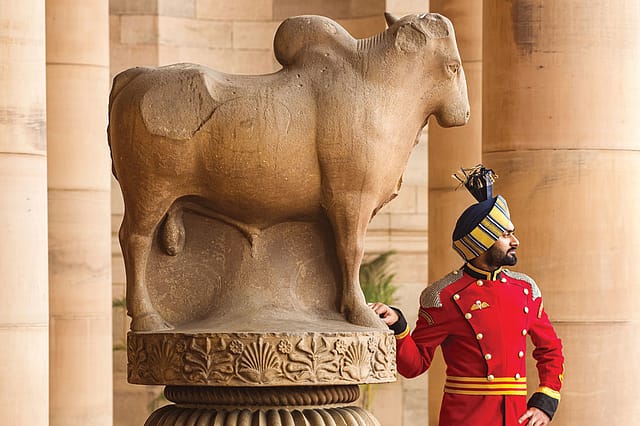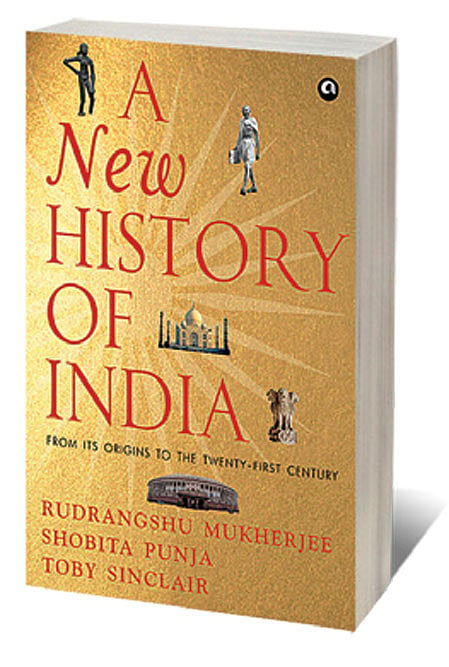Who Are We?

BREAKING FROM THE James Mill tradition of dividing Indian history into a Hindu, Muslim and Christian era, a division long discredited in academic historiography, Rudrangshu Mukherjee, Shobita Punja, and Toby Sinclair rectify the balance by devoting 165 pages to India before the Delhi Sultanate, cover the Sultanate in 18 crisp pages and the Great Moghuls in no more than 22, while devoting a hundred to the British period and the next hundred to the freedom struggle, before turning to the emergence of an independent (if mutilated) India over the next one hundred pages in their book A New History of India. The arithmetic should satisfy the most exacting of the NCERT’s ‘scholars’.
The thrust of India’s history remains the same as in the older Nehruvian version and the present ‘New’ history: an India that through five millennia had welcomed and learned from centuries of foreign conquest that led to absorption, assimilation and synthesis between old ideas and new, that sparked revolutions in the thinking of those already settled in the land and the outsiders who came to also settle down as children of Mother India. Hence the key chapters on ‘Society and Ideas in the Age of the Vedas’ that followed on the disappearance of more than a millennium of pre-Aryan Harappan culture, and the later chapters on the ‘Influence of Islam’ and the chapter on ‘Indian Response and Resistance’ to the ‘Consolidation of British Rule’.
2026 New Year Issue
Essays by Shashi Tharoor, Sumana Roy, Ram Madhav, Swapan Dasgupta, Carlo Pizzati, Manjari Chaturvedi, TCA Raghavan, Vinita Dawra Nangia, Rami Niranjan Desai, Shylashri Shankar, Roderick Matthews, Suvir Saran
What is ‘New’ about this history is not that it is ‘revisionist’ but that, thanks to the contributions of Mukherjee’s co-authors, the heritage expert Shobita Punja, and the brilliant photographer Toby Sinclair, the ‘Idea of India’ has been given additional visual dimensions that fill out the ancient and consistent lineage of India’s “unity in diversity”. The visual evidence cannot be denied or distorted as the written word can be. At a time when our history is being subjected to distortion, a work such as this is an essential statement of the truth of the evolution of India’s unique identity.
The volume also has the advantage of brevity in packing into under 450 pages a synoptic view of the development of Indian civilisation into the multifaceted phenomenon it is, open to the world and regarding all of human heritage as a deep well to draw upon. As Mahatma Gandhi said: “I do not want my house to be walled in on all sides and my windows to be stuffed. I want the cultures of all lands to blow about my house as freely as possible. But I refuse to be blown off my feet by any.”
That is the picture captured in this multi-disciplinary history on camera and the arts animated by a well-studied narrative that binds the distant past to the present and presents a future of the “sunlit uplands” if we allow our past to mentor the nation’s destiny. That would be true patriotism, true nationalism.
New History is also distinguished by its treatment of the whole of India’s history, not just happenings on the Indo- Gangetic plains, as is often the case in our schools and even colleges. There is an entire chapter on the Northeast, full of the most fascinating insights into the domination over the tribals of the Bhuyans, who were mostly “high-caste migrants from North India”, including some Muslims, and who wielded political and administrative power primarily through their thorough grasp of “the scriptures, mensuration, and arithmetic” besides their “ability to use arms”. The book tells the tragic tale of a devastating civil war between 1770 and 1809 that halved the population of the region and facilitated the Burmese invasion of Ahom lands until the British intervened and drove out the Burmese, signing the Treaty of Yandabo in 1826. Although the British portrayed themselves as the “saviours” of Assam, in fact they imposed “planters raj that lorded over and tyrannized the entire people of the region”. Strangely, there is nothing about the Ahoms driving back the Mughals.
As for the many dynasties of the Deccan and those of the deep south, a great deal is recounted but, curiously, the chapter is headed, ‘Breakdown of the Gupta Empire’ although Mukherjee readily admits at the very start of the chapter that “historical trends in peninsular India or the Deccan do not march to the drumbeat of events and developments in North India”. He hastens to add that there was, however, “a vibrant interaction between the local culture and the expanding culture based on Sanskrit learning and tradition”. This is well illustrated in Tamil Nadu where “only Tamil” was initially used in inscriptions but later the “formulaic part” was in Sanskrit followed by “the main body of the text in Tamil”. The author invokes the Rashtrakutas, who controlled trade with the Arabs through ports on the edges of the Western Ghats; the later Chalukyas of Badami and the various other Deccan kingdoms of the Ishvakus and others. He then travels further south to the land of the Pallavas, who built Mahabalipuram, and the later Cheras, Cholas and Pandyas. Of these, the Cholas left the deepest imprint, “not so much out of their political authority as from the cultural life under their rule”, setting “new standards of excellence…which became part of the living tradition of South India”.
In another chapter on ‘Regional Kingdoms’, the authors deal with Bengal where their most interesting observation is that repeated rebuffs to the Delhi Sultanate by the governors Delhi sent out to Bengal resulted in two centuries of isolation from the main empire that “enabled Bengal to fashion its own regional identity”. The chapter then goes on to the Vijayanagar kingdom whose most prominent ruler was Krishan Deva Raya. His most lasting contribution was the wonder of Hampi. Towards the middle of the 14th century, the Bahmani kingdom was established in Daulatabad and was replaced towards the end of the 15th century, by the Nizam Shahi dynasty, based in Ahmednagar. It was under these two dynasties that the Indo-Persianate relationship got entrenched, the shining star of which was Firishta, whose ruler Ibrahim Adil Shah II, commissioned Firishta to tell the story of Hindustan “in plain language, without artifice or lies”— an injunction that ought to reverberate in the august corridors of NCERT. Firishta went on to “assimilate all these geographies and histories into a unified history of Hindustan”. Moreover, the Persian connection “embraced the principle of universal justice and accommodated cultural diversity”, elevating “justice not religion as the measure of proper governance”.
Arguably, the most interesting chapter in the book is the one on ‘The Influence of Islam’, which, significantly, is almost entirely devoted to a close description and analysis of the interaction between the Hindu Bhakti movement and the Muslim Sufi movement that shaped the Hindu-Muslim and Indo- Persianate encounter from the 13th to the 18th centuries. Pointing out that “when Islam arrived in this region there was no transition from Hinduism to Islam”, the authors argue that “the arrival of Islam brought a new momentum” which fashioned “new forms of piety, aesthetic sensibilities… and became an integral part of the plurality of Indian history and culture.” Stressing that “religious eclecticism and tolerance was manifest in the Bhakti movement”, promoted principally by Kabir and his followers, alongside regional spiritual leaders like Eknath, Tukaram, and Ramdas in Maharashtra; Chaitanya and the Bauls in Bengal; Ramananda, Raidas and Vallabhacharya in the south; Mirabai as the “pre-eminent voice” in Rajasthan, the movement is depicted as not merely creating a synthesis between what went before and the new thoughts that had come with the Muslims but also the blowback against orthodoxy and Brahmin domination. In particular, there was “a great deal of overlap and convergence between the Bhakti mystical tradition and Sufism”. The next chapter traces the development of Sikhism, which many would regard as the apogee of the synthesis of Hindu and Islamic spiritualism.

